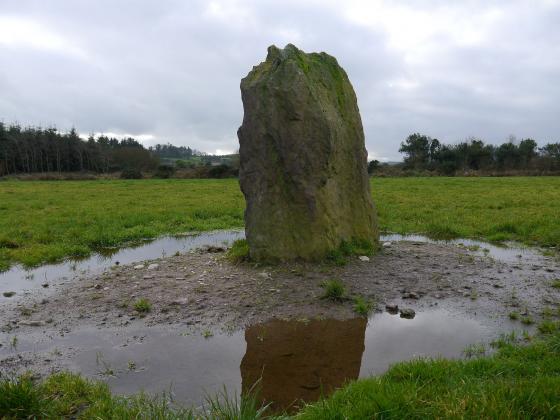
Aerial view of Knockavilla fort

Aerial view of Knockavilla fort

Aerial view of the cairn at Knockavilla

Aerial view of the cairn at Knockavilla.

Aerial photograph of the cairn at Knockavilla

Taken from the bottom of the ditch, looking up at the reconstructed inner defence wall.

Reconstruction of the entrance timbers and the passage to the interior of the fort.

The ditch, with a plausible reconstruction of the oak posts of the inner wall above to the right.

Looking back towards the entrance with the timber palisade reconstruction to the right. The very slight curve, even at quite a distance, gives an indication of the scale of the perimeter.
Just before the summer I went to a talk given by Professor O’Brien on the prehistory of the Dunmanway area. While the first half of his presentation was a steady trot around the expected topic, he spent the rest of the time speaking about his excavation at Clashanimud, a townland that he ventured to translate as ‘the trench of the timber’. It’s possible that some folk memory remained into historic times of this massive wooden construction.
I’ve included the newpaper report from August in the miscellaneous section below, as a reasonable summary of his findings. On visiting the site myself in early June I found access to be easy, with a parking spot just up the hill from the entrance at the eastern side.
Taken from the Irish Examiner dated August 21 2007. A front page article by, appropriately, Sean O’Riordan.
“Archaeologists uncover county’s ‘first capital‘
Archaeologists believe that they have discovered what may have been Cork’s ancient capital, built 3200 years ago at a time when Rameses III was pharaoh of Egypt.
A team of archaeologists from UCC, led by Professor William O’Brien, have carried out extensive research that sheds new light on what is the largest prehistoric monument in Co. Cork and the oldest dated ringfort in the country.
Their three-year project, funded by the Irish Research Council for Humanities and Social Sciences and the Royal Irish Academy, shows that huge wooden defence walls once surrounded the ringfort at Knockavilla, near Innishannon.
Radiocarbon dating shows that the ringfort was constructed about 1200 BC, confirming it as the oldest known prehistoric ringfort in Ireland and, according to Professor O’Brien, this puts its importance on a par with prehistoric sites such as Dún Aengus on Inishmore and Mooghaun, Co. Clare.
Archaeologists have concluded that several thousand timber posts surrounded the ancient structure, known as the “cathair”, which enclosed nearly 20 acres – enough space for today’s developers to construct about 300 houses.
It would have taken hundreds, if not thousands, of people to construct it and may have been built in a matter of months.
“The antiquity and immense size of this monument suggests that it was one of the most important prehistoric settlements in the south-west region, and arguably Cork’s first capital,” said Professor O’Brien.
The outer defence walls had a perimeter of more than one kilometre and were built with wattle fencing. These were erected behind a dug-out ditch defence.
The inner timber defence, built entirely of solid oak, was 800m at its perimeter. Archaeologists discovered evidence that part of the inner palisade fence had been burnt, which Professor O’Brien and his team believe “was a deliberate act of war”.
The people who built the ringfort may have been slaughtered. At any rate their kingdom seems to have disintegrated as no efforts were made to repair the fort and it was never inhabited again.”


































